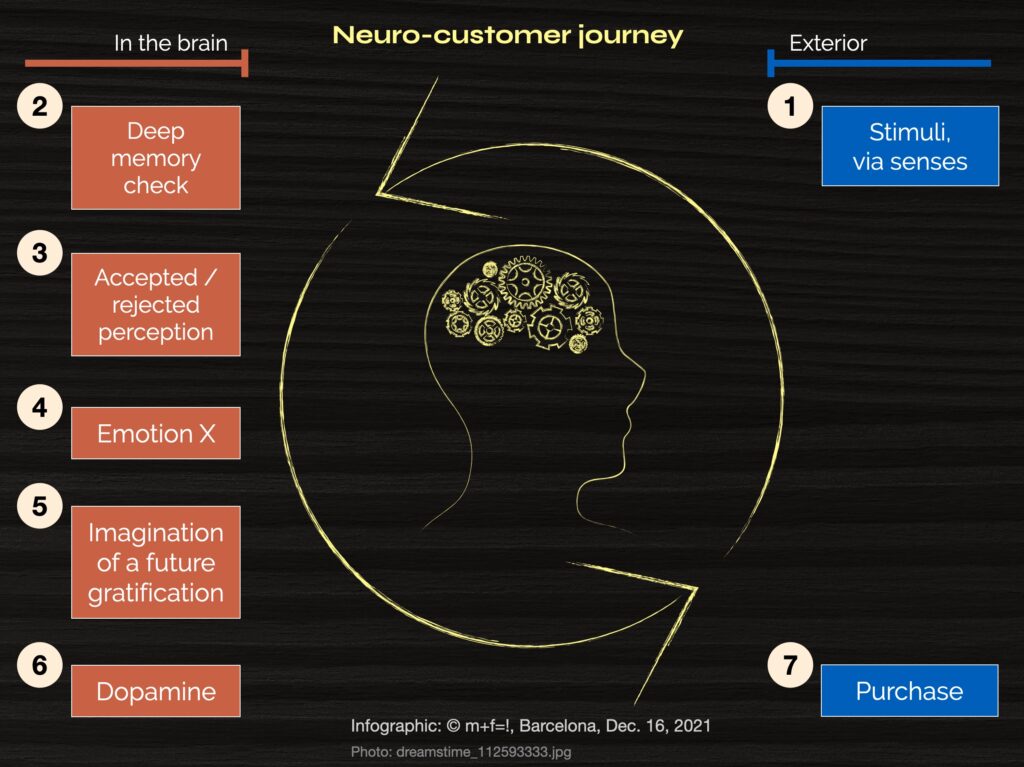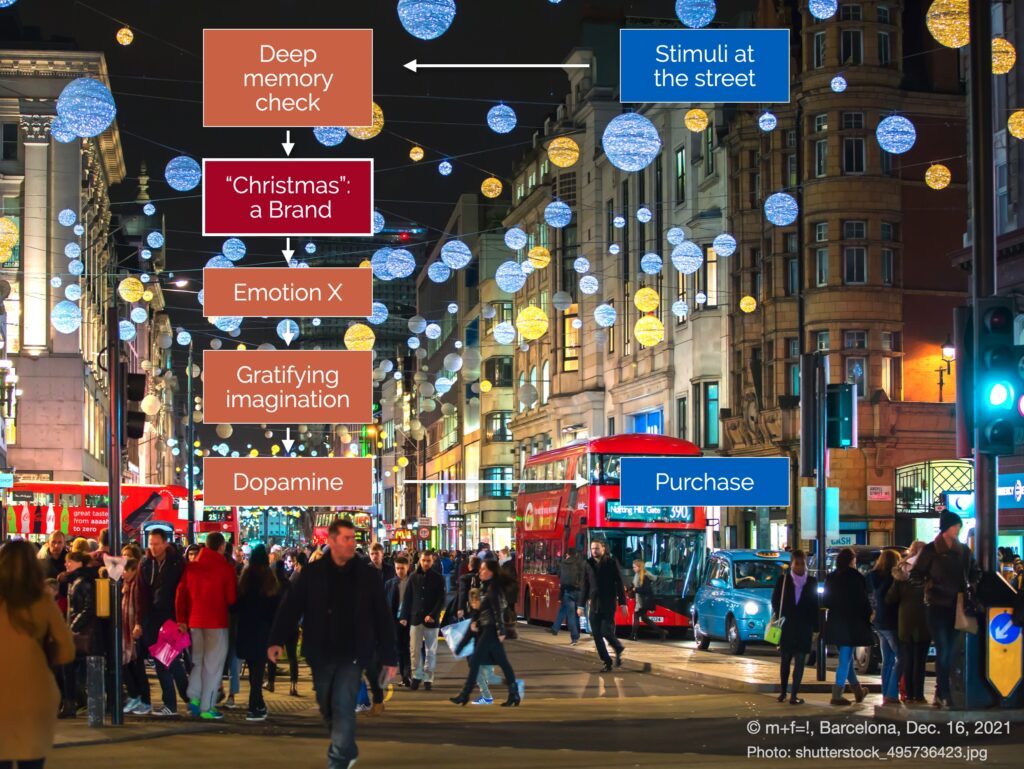Every year, around Christmas time, a some media usually contact me asking me to explain what techniques are used by shops – including e-shops – to get consumers to end up buying more, without even realising it.
The repertoire is well known. From displaying products on a shelf in a certain way to form an important visual mass, to placing impulse-buying products in areas where people tend to get bored – such as by a checkout queue – to scenting certain areas, playing livelier music, and so on.
However, hardly anyone mentions a scientifically proven stimulus:
an attendant’s smile is the greatest emotional trigger possible, even at checkouts.
Smiling and being smiled at generates oxytocin in people, and oxytocin is a neurotransmitter contributing to building personal relationships. That is why it is called the love neurotransmitter. Without any technical doubt, it is something that drives customer loyalty.
If we translate this into the world of business, smiles promote sustained cash flow, as the CEO Jose Ángel Remírez proved when he was in charge of supermarket chain Nekea. Their sales increased by 4% simply as a result of a project we collaborated with them on involving generating genuine smiles in their team.
Paradoxically, even though a smile is a highly effective method, as well as the least expensive, it is among the least mentioned in business literature.
A customer’s neuro-journey
In a very simplified way, these are the stages of a customer’s neuro-journey, from the moment certain stimuli appear to the moment when the person buys a product or service.
It makes no difference whether that person is buying something for themselves (B2C) or for their company (B2B).

Everything starts when a person’s senses detect a stimulus. This may be a song, a smell, an image, a geometric shape, a website, something lit in some special way…, or a smile. These ‘stimuli’ can also be called ‘sense data’ – i.e., data that are perceived by the human senses.
Such stimuli are transmitted, at extremely high speed, to the place where we have what I metaphorically call the ‘Marie Kondo boxes’, that is, the deep memory.

More technically speaking, the electric current generated by stimuli travels to the hippocampus, where deep memory begins to form.
Then, a contrast – or a debate – takes place between what is detected by the senses and what was already in the memory. This dialogue takes place to correctly decide the person’s behaviour after perceiving something via their senses.
For every bit captured by the senses, memory will ‘respond’ with 6 bits. If we interpret this in practical terms, a completely new message or stimulus is – in principle – not very likely to make something change when it is already consolidated in someone’s mind.

The outcome of this contrast between what is detected outside and what is stored inside triggers one of over 400 possible emotions.
This emotion will be reflected on the body, either through a facial expression, a heart-rate change, perspiration, or in certain brain waves.
At virtually the same time, something happens that is specific to people: we imagine what could happen to us in the future if we had, or if we bought, such thing.
Although the present is the only reality, people tend to live on the next screen, in the next chapter.
When a person imagines that things will go well for them, i.e., when they visualise a future gratification, a release of dopamine takes place – and dopamine is the pleasure neurotransmitter. That is when that person’s brain will say to them, ‘Yes, do it!’. And, although there is not any Buy Button, the anticipated pleasure will increase the likelihood of a purchase taking place.
Six practical implications
So, propensity to purchasing whatever you are selling (a product, service or idea) will be higher if…
- What you do or say can be more easily captured by the senses of your potential customers if you surprise them. As we are living in an infoxicated society (a term I learned from Alfons Cornella) it’s not easy to grab their attention. For example, you should not send typical messages like ‘Merry Christmas and a Happy New Year!’. If you do, people will pay no attention, you will be wasting your time and it may even harm your reputation as someone working to create a better future.
- Let your team – including yourself – be made up of people who can smile easily. Your quality of life will be better, and you will get results. At m+f=!, we can vouch for that!
- Whatever you do or say, let it include two elements: (A) Something that makes people feel some potential future gratification; and (B) something the receiver will pleasantly link to some mental image already in their memory. I can now recall how designer Pep Valls often told me that, for his creations, he also looked for ‘form memory’.
- But do not try to stir too many emotions! Pareto (author of the famous 20/80 law) is still relevant today; that is, focusing on evoking a particular emotion is more effective than trying to provoke many emotions. The risk of such a cocktail is the loss of focus, something essential in our attention-lacking society. Strategy is a denial exercise, as my beloved and admired professor Paco Vilahur used to say.
- If you express your message through an intense, positive experience, its recall will increase. Before storing stimuli in our deep memory, the amygdala assigns a high emotional load to those strongly experienced stimuli.
- Many things can change if, when comparing what is perceived by the senses with what is inside ‘Marie Kondo boxes’, there, the recently arrived stimuli find a strong brand.
This important aspect is developed below, outside of this list.
Let us imagine that a person walks out onto the street and they find it lit up with unusual, beautifully shaped, colourful, even magical hanging lights. Those stimuli captured by the senses are delivered to the person’s “Marie Kondo boxes”, and the deep memory ‘tells’ them: ‘That’s because it’s Christmas!’.
Then, a smile appears on their face and they observe how many others around them also have happy faces. Everything fits.
Using cognitive neuroscience, ‘Christmas’ is a mental representation evoking an important gratification for many people.

In other words, Christmas is a brand.
More specifically, a brain-pleasing brand:
a mental representation evoking a powerful gratification.
Here, I am talking about Christmas, but I could just as well be talking about Ramadan for Islamic countries. If you travel to Turkey for Ramadan, you will get a feel of what that brand means to them in their cultural context.
When you add the power of a brain-pleasing brand to the customer neuro-journey, the likelihood of persuading them or them buying whatever you are selling will increase exponentially.
That is why, strictly speaking, what some city mayors achieve during Christmas by livening up their streets with theatricalisation – not just only lighting – is more effective at increasing retail sales than any visual merchandising techniques.
For retailers, it is almost enough to ensure that the feelings related to the Christmas brand can also be perceived in their physical or digital stores.
If City Mayors want to promote local retail at Christmas, the result will be better if they invest money on the theatricality of their streets than in an advertising campaign in favour of shopping in the city’s stores.




